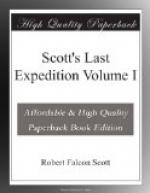In Winter Quarters: Modern Style
Monday, May 15.—The wind has been strong from the north all day—about 30 miles an hour. A bank of stratus cloud about 6000 or 7000 feet (measured by Erebus) has been passing rapidly overhead towards the north; it is nothing new to find the overlying layers of air moving in opposite directions, but it is strange that the phenomenon is so persistent. Simpson has frequently remarked as a great feature of weather conditions here the seeming reluctance of the air to ’mix’—the fact seems to be the explanation of many curious fluctuations of temperature.
Went for a short walk, but it was not pleasant. Wilson gave an interesting lecture on penguins. He explained the primitive characteristics in the arrangement of feathers on wings and body, the absence of primaries and secondaries or bare tracts; the modification of the muscles of the wings and in the structure of the feet (the metatarsal joint). He pointed out (and the subsequent discussion seemed to support him) that these birds probably branched at a very early stage of bird life—coming pretty directly from the lizard bird Archaeopteryx of the Jurassic age. Fossils of giant penguins of Eocene and Miocene ages show that there has been extremely little development since.
He passed on to the classification and habitat of different genera, nest-making habits, eggs, &c. Then to a brief account of the habits of the Emperors and Adelies, which was of course less novel ground for the old hands.
Of special points of interest I recall his explanation of the desirability of embryonic study of the Emperor to throw further light on the development of the species in the loss of teeth, &c.; and Ponting’s contribution and observation of adult Adelies teaching their young to swim—this point has been obscure. It has been said that the old birds push the young into the water, and, per contra, that they leave them deserted in the rookery—both statements seemed unlikely. It would not be strange if the young Adelie had to learn to swim (it is a well-known requirement of the Northern fur seal—sea bear), but it will be interesting to see in how far the adult birds lay themselves out to instruct their progeny.
During our trip to the ice and sledge journey one of our dogs, Vaida, was especially distinguished for his savage temper and generally uncouth manners. He became a bad wreck with his poor coat at Hut Point, and in this condition I used to massage him; at first the operation was mistrusted and only continued to the accompaniment of much growling, but later he evidently grew to like the warming effect and sidled up to me whenever I came out of the hut, though still with some suspicion. On returning here he seemed to know me at once, and now comes and buries his head in my legs whenever I go out of doors; he allows me to rub him and push him about without the slightest protest and scampers about me as I walk abroad. He is a strange beast—I imagine so unused to kindness that it took him time to appreciate it.




